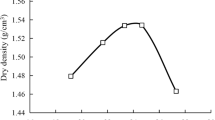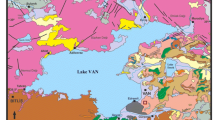Abstract
This paper discusses the hydraulic conductivity (k) of peat and organic clay as measured by laboratory and in-situ tests. The k of various peat soils and organic clay soils in Hokkaido, Japan, was investigated by the following tests: in-situ hydraulic conductivity test using a borehole, electric cone penetration test, oedometer test, and laboratory hydraulic conductivity test. The k of peat and organic clay dramatically decreases during consolidation. The index of change in k, which indicates consolidation-related changes in k, increases linearly with the increase in the in-situ void ratio and the ignition loss. The k of peat measured by oedometer test was found to range from approximately 1/20 to 1/180 of that measured by in-situ hydraulic conductivity test, which is considered to provide the macroscopic k of peat ground. Since large plant remnants must be removed for the oedometer testing of peat, the laboratory k obtained from this test underestimates the macroscopic k of the peat layer. The ratio of laboratory k to in-situ k can be simply expressed as a function of the ignition loss. Based on the results of a dissipation test of pore water pressure that used the electric cone penetration test, an equation for estimating the in-situ k of peat ground is presented. Using the above-mentioned experimental correlations, a suitable procedure for determining the permeability parameters of peat ground in practical applications is proposed.


















Similar content being viewed by others
References
Baligh M, Levadoux J (1986) Consolidation after undrained piezocone penetration, II: interpretation. J Geotech Eng ASCE 112(7):727–745
Hanrahan ET (1954) An investigation of some physical properties of peat. Geotechnique 4(3):108–123
Hayashi H , Mitachi T, Nishimoto S (2011) Permeability parameters for FE analysis of peat ground. In: Proceedings of 14th Asian regional conference on SMGE (CD-R)
Hayashi H, Nishikawa J, Odajima H, Mitachi T, Fukuda F (1994) Deformation analysis of peat ground with cam clay model. In: Proceedings of the international symposium on pre-failure deformation characteristics of geomaterials, Sapporo, vol 1, pp 575–581
Hayashi H, Mitachi T, Nishimoto S (2008) Evaluation on permeability of peat using in-situ permeability test and oedometer test. J Geotech Eng JSCE 64(3):495–504 (in Japanese)
Hayashi H, Yamanashi T (2015) Estimation of hydraulic conductivity in peat and organic clay deposits. In: Proceedings of 16th European conference on soil mechanics and geotechnical engineering, Edinburgh, pp 2401–2406
Huat BBK, Prasad A, Asadi A, Kazemian S (2014) Geotechnics of organic soils and peat. CRC Press, Boca Raton, pp 97–120
Hvorslev MJ (1951) Time lag and soil permeability in ground water observations. Waterways Experiment Station, Corps of Engineers, U.S. Army. No. 36
Japanese Geotechnical Society (JGS) (2015) Japanese Geotechnical Society standards for geotechnical and geoenvironmental investigation methods, vol 1, JGS 1221
Japanese Geotechnical Society (JGS) (2016) Japanese Geotechnical Society standards for geotechnical and geoenvironmental investigation methods, vol 2, JGS 1435
Japanese Geotechnical Society (JGS) (2018) Japanese Geotechnical Society standards for geotechnical and geoenvironmental investigation methods, vol 3, JGS 1314
Japanese Industrial Standard (JIS) (2009) Test method for one-dimensional consolidation properties of soils using incremental loading (in Japanese)
Kogure K, Ohira Y, Yamaguchi H (1988) Permeability anisotropy of fibrous peat in a permeameter. In: Proceedings of 5th Australia and New Zealand conference on geomechanics, pp 150–154
Kogure K (1995) Geoengineering of highly organic soils. Toyo-shoten Co., Ltd., Tokyo, pp 56–68 (in Japanese)
Landva AO, Pheeney PE (1980) Peat fabric and structure. Can Geotech J 17(3):416–435
Lea N, Brawner CO (1963) Highway design and construction over peat deposits in the lower mainland region of British Colombia. Highw Res Rec No 7:1–32
Leroueil S, Lerat P, Hight DW, Powell JJM (1992) Hydraulic conductivity of a recent estuarine silty clay at Bothkennar. Geotechnique 42(2):275–288
Mesri G, Stark TD, Ajlouni MA, Chen CS (1997) Secondary compression of peat with or without surcharging. J Geotech Eng ASCE 123(5):411–421
Mesri G, Ajlouni M (2007) Engineering properties of fibrous peats. J Geotech Geoenviron Eng ASCE 133(7):850–866
Noto S (1991) Peat engineering handbook. CERI, Sapporo, pp 102–110
Ohira Y (1971) Peat—engineering properties, investigation and design—. Sekohgizyutsu 4(6):146–148 (in Japanese)
Oikawa H (1989) A method for predicting e-log p curve and log cv-log p curve of a soft soil from its natural water content. J Geotech Eng JSCE 412:43–49 (in Japanese)
Osaki M, Tsuji N (2016) Tropical peatland ecosystems. Springer, Berlin
Robertson P, Sully J, Woeller D, Lunne T, Powell J, Gillespie D (1992) Estimating coefficient of consolidation from piezocone tests. Can Geotech J 29:539–550
Tanaka H, Hayashi H, Yamazoe N (2019) Reconsideration of the settlement behavior of peat from view point of hydraulic conductivity. Soils Found 59(2):316–325
Tanaka H, Sakakibara M, Goto K, Suzuki K, Fukazawa T (1992) Properties of Japanese normally consolidated marine clays obtained from static piezocone penetration test. Rep Port Harb Res Inst 31(4):62–92 (in Japanese)
Tavenas F, Jean P, Leblond P, Leroueil S (1983) The permeability of natural soft clays. Part II: permeability characteristics. Can Geotech J 20(3):645–660
Yamaguchi H, Matsuo K, Ohira Y, Kogure K (1986) Geotechnical properties of peats and peaty grounds. J Geotech Eng JSCE 370:271–280 (in Japanese)
Yamazoe N, Mitachi T (2007) Finite deformation elasto-plastic FE analysis on the peat ground under vacuum surcharge preloading. J Geotech Eng JSCE 63(4):1113–1131 (in Japanese)
Yamazoe N, Tanaka H, Hayashi H, Mitachi T (2011) Settlement-time behavior of peat ground and applicability of conventional predicting methods. Jpn Geotech J JGS 6(3):395–414 (in Japanese)
Acknowledgements
The authors wish to express deep gratitude to Emeritus Prof. Hiroyuki Tanaka of Hokkaido University and Associate Prof. Nobutaka Yamazoe of the National Institute of Technology, Akita College, for their valuable advice.
Author information
Authors and Affiliations
Corresponding author
Additional information
Publisher's Note
Springer Nature remains neutral with regard to jurisdictional claims in published maps and institutional affiliations.
Rights and permissions
About this article
Cite this article
Hayashi, H., Hatakeyama, O. Measuring the Hydraulic Conductivity of Peats and Organic Clays with Various Characteristics. Geotech Geol Eng 39, 517–531 (2021). https://doi.org/10.1007/s10706-020-01510-3
Received:
Accepted:
Published:
Issue Date:
DOI: https://doi.org/10.1007/s10706-020-01510-3




